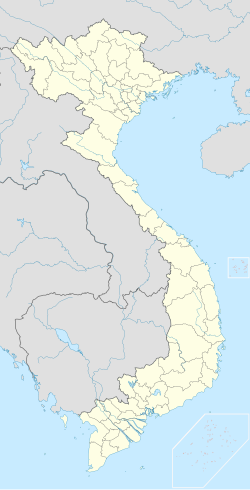Sơn Tây, Hanoi
You can help expand this article with text translated from the corresponding article in Vietnamese. (October 2023) Click [show] for important translation instructions.
|
21°08′N 105°30′E / 21.133°N 105.500°E
Sơn Tây
Thị xã Sơn Tây | |
|---|---|
| Sơn Tây Town | |
 | |
 | |
| Coordinates: 21°8′N 105°30′E / 21.133°N 105.500°E | |
| Country | |
| Municipalities | Hanoi |
| Area | |
• Total | 113.5 km2 (43.8 sq mi) |
| Population (2018) | |
• Total | 230,577 |
| • Density | 2,031/km2 (5,260/sq mi) |
Sơn Tây () is a district-level town ("thị xã") in Hanoi, the capital of Vietnam. It was the capital of Sơn Tây province before merging with Hà Đông province to form Hà Tây province in 1965. Sơn Tây lies 35 km west of the capital Hanoi. It had a city status in Hà Tây province. However, when Hà Tây was absorbed into Hanoi, Sơn Tây was demoted from a city to a town.[1]
It is often referred to as “soldier town” due to the proliferation of army barracks and military institutions that surrounds the town, including the Vietnamese People's Army Infantry Academy.
Sơn Tây's future is seen as being very much that of a satellite city of Hanoi and as a result there are plans to relocate universities and other public facilities to Sơn Tây where land is cheaper and more plentiful. The government has planned to complete this project by duplicating the main Hanoi—Sơn Tây carriageway which is expected to be completed in 2009.
History
[edit]-
Sơn Tây citadel, 1884
-
A Vietnamese cash coin with the characters Sơn Tây (山西) written on it from right-to-left. This coin was produced by the Sơn Tây Mint.
-
Drawing of Sơn Tây citadel in the Nguyễn dynasty
Sơn Tây is known for its thousand year old villages, such as Đường Lâm which retains a collection of vernacular architecture with buildings and temples built using laterite bricks. Và Temple, or Đông Cung, dedicated to T��n Viên, is located on a hill covered with ironwood trees in Vân Giã hamlet, Trung Hưng commune.[2] Phạm Văn Đổng, a general of the Saigon regime, was from Sơn Tây.
Climate
[edit]| Climate data for Sơn Tây | |||||||||||||
|---|---|---|---|---|---|---|---|---|---|---|---|---|---|
| Month | Jan | Feb | Mar | Apr | May | Jun | Jul | Aug | Sep | Oct | Nov | Dec | Year |
| Record high °C (°F) | 31.4 (88.5) |
34.0 (93.2) |
38.0 (100.4) |
40.4 (104.7) |
40.5 (104.9) |
41.6 (106.9) |
40.1 (104.2) |
39.1 (102.4) |
37.5 (99.5) |
35.6 (96.1) |
34.0 (93.2) |
31.2 (88.2) |
41.6 (106.9) |
| Mean daily maximum °C (°F) | 19.7 (67.5) |
20.7 (69.3) |
23.4 (74.1) |
27.7 (81.9) |
31.8 (89.2) |
33.2 (91.8) |
33.2 (91.8) |
32.5 (90.5) |
31.5 (88.7) |
29.3 (84.7) |
25.8 (78.4) |
22.1 (71.8) |
27.6 (81.7) |
| Daily mean °C (°F) | 16.3 (61.3) |
17.6 (63.7) |
20.2 (68.4) |
24.0 (75.2) |
27.2 (81.0) |
28.9 (84.0) |
28.9 (84.0) |
28.4 (83.1) |
27.3 (81.1) |
25.0 (77.0) |
21.5 (70.7) |
17.9 (64.2) |
23.6 (74.5) |
| Mean daily minimum °C (°F) | 14.1 (57.4) |
15.6 (60.1) |
18.2 (64.8) |
21.5 (70.7) |
24.2 (75.6) |
25.9 (78.6) |
26.0 (78.8) |
25.7 (78.3) |
24.7 (76.5) |
22.3 (72.1) |
18.5 (65.3) |
15.3 (59.5) |
21.1 (70.0) |
| Record low °C (°F) | 4.6 (40.3) |
5.4 (41.7) |
4.5 (40.1) |
13.0 (55.4) |
17.3 (63.1) |
20.4 (68.7) |
19.5 (67.1) |
19.8 (67.6) |
17.2 (63.0) |
14.4 (57.9) |
9.2 (48.6) |
5.1 (41.2) |
4.5 (40.1) |
| Average rainfall mm (inches) | 25.6 (1.01) |
24.6 (0.97) |
43.3 (1.70) |
96.1 (3.78) |
216.6 (8.53) |
262.9 (10.35) |
311.8 (12.28) |
314.6 (12.39) |
224.3 (8.83) |
158.4 (6.24) |
63.0 (2.48) |
22.0 (0.87) |
1,751.2 (68.94) |
| Average rainy days | 9.7 | 11.1 | 14.6 | 13.5 | 15.5 | 15.6 | 16.9 | 16.5 | 13.1 | 9.7 | 6.9 | 6.0 | 149.1 |
| Average relative humidity (%) | 83.8 | 85.0 | 86.7 | 87.2 | 84.6 | 82.9 | 83.6 | 85.4 | 84.6 | 82.4 | 81.3 | 80.4 | 84.0 |
| Mean monthly sunshine hours | 65.5 | 48.8 | 49.3 | 91.6 | 172.4 | 165.4 | 181.1 | 173.4 | 170.5 | 151.3 | 130.5 | 108.9 | 1,494.7 |
| Source: Vietnam Institute for Building Science and Technology[3] | |||||||||||||
Administrative divisions
[edit]The town of Sơn Tây occupies most of the district, and is subdivided in wards. Eight wards form the urban core, while Xuân Khanh, to the west, is a distant ward, discontinuous with the central area. The district also includes six rural communes: Cổ Đông, Đường Lâm, Kim Sơn, Sơn Đông, Thanh Mỹ, and Xuân Sơn.
See also
[edit]References
[edit]- ^ [1] Proposal to re-establish Sơn Tây City
- ^ Minh Trị Lưu - Historical remains & beautiful places of Hanoi and the surrounding areas - Page 204 2000 "Và Temple locates on a hill covered with green of old-age ironwood trees in Vân Gia hamlet, Trung Hưng ward, Sơn Tây town. Và Temple is differently called Đông Cung (East palace), dedicating to God Tản Viên"
- ^ "Vietnam Institute for Building Science and Technology" (PDF).
External links
[edit]- Duong Lam village travel guide and tips
- Cổng thông tin Người Sơn Tây
- Diễn đàn Người Sơn Tây
- Hanoi province and its subdivisions






